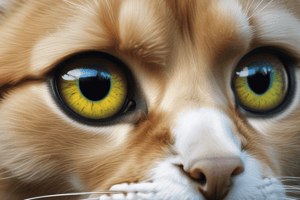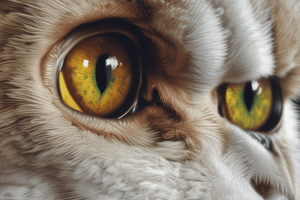Podcast
Questions and Answers
What percentage of eyes experienced recurrent ulceration?
What percentage of eyes experienced recurrent ulceration?
- 3/17 (correct)
- 5/17
- 7/17
- 1/17
What was the outcome for the two eyes with a SK?
What was the outcome for the two eyes with a SK?
- They experienced complete healing (correct)
- They had a further decline in health
- They were euthanized due to decline in health
- They required ongoing treatment
What was the reason for euthanizing one of the eyes with recurrent ulceration?
What was the reason for euthanizing one of the eyes with recurrent ulceration?
- The eye was in severe pain
- The eye had a severe infection
- The animal had a decline in health from chronic kidney disease (correct)
- The eye was blinded
How many eyes experienced a decline in health from chronic kidney disease?
How many eyes experienced a decline in health from chronic kidney disease?
What was the result of the recurrent ulceration in the eyes?
What was the result of the recurrent ulceration in the eyes?
What was the diameter of the PureVision bandage contact lens used in the procedure?
What was the diameter of the PureVision bandage contact lens used in the procedure?
How many eyes had a BCL placed post-procedure?
How many eyes had a BCL placed post-procedure?
Who was responsible for deciding whether to place a BCL post-procedure?
Who was responsible for deciding whether to place a BCL post-procedure?
What is the name of the company that manufactured the PureVision bandage contact lens?
What is the name of the company that manufactured the PureVision bandage contact lens?
What was the purpose of placing a BCL post-procedure?
What was the purpose of placing a BCL post-procedure?
What was the primary material used to create the double drape tectonic patch?
What was the primary material used to create the double drape tectonic patch?
What was the intended purpose of the double drape tectonic patch?
What was the intended purpose of the double drape tectonic patch?
What type of lens was used in the procedure?
What type of lens was used in the procedure?
How many cases were involved in the study?
How many cases were involved in the study?
In which journal was the study published?
In which journal was the study published?
What is the potential benefit of a fast and effective treatment method for corneal ulceration?
What is the potential benefit of a fast and effective treatment method for corneal ulceration?
What was the primary finding of Morgan et al.'s study in 1994?
What was the primary finding of Morgan et al.'s study in 1994?
How much shorter was the time to healing of corneal ulceration with surgical intervention compared to medical therapy alone?
How much shorter was the time to healing of corneal ulceration with surgical intervention compared to medical therapy alone?
What was the average time to healing of corneal ulceration with medical therapy alone?
What was the average time to healing of corneal ulceration with medical therapy alone?
What was the average time to healing of corneal ulceration with surgical intervention?
What was the average time to healing of corneal ulceration with surgical intervention?
What is the main purpose of diamond burr debridement in dogs?
What is the main purpose of diamond burr debridement in dogs?
What is the role of postoperative medical therapies in the context of corneal healing?
What is the role of postoperative medical therapies in the context of corneal healing?
How does bandage contact lens wear affect corneal healing rate?
How does bandage contact lens wear affect corneal healing rate?
What is the primary goal of using diamond burr debridement and postoperative medical therapies?
What is the primary goal of using diamond burr debridement and postoperative medical therapies?
What is the significance of assessing corneal healing rate in dogs?
What is the significance of assessing corneal healing rate in dogs?
Flashcards are hidden until you start studying
Study Notes
Corneal Defect Repair with Cyanoacrylate Glue
- A double drape tectonic patch with cyanoacrylate glue was used to repair corneal defects in 8 cases.
Post-Procedure Care
- A bandage contact lens (BCL) was placed in 18/21 eyes after the procedure to aid in healing.
- The BCL used was a 14-mm-diameter PureVision bandage contact lens, manufactured by Bausch and Lomb Incorporated.
Corneal Ulceration
- Recurrent ulceration occurred in 3/17 eyes, with two cases having a superficial keratectomy (SK) and complete healing, and one case being euthanized due to declining health from chronic kidney disease.
Corneal Healing Rate
- Surgical intervention can expedite corneal healing, discouraging corneal sequestrum formation.
- A study by Morgan et al. (1994) found that the time to healing of corneal ulceration was significantly shorter with surgical intervention (3.8 weeks) compared to medical therapy alone (11.2 weeks).
Studying That Suits You
Use AI to generate personalized quizzes and flashcards to suit your learning preferences.




